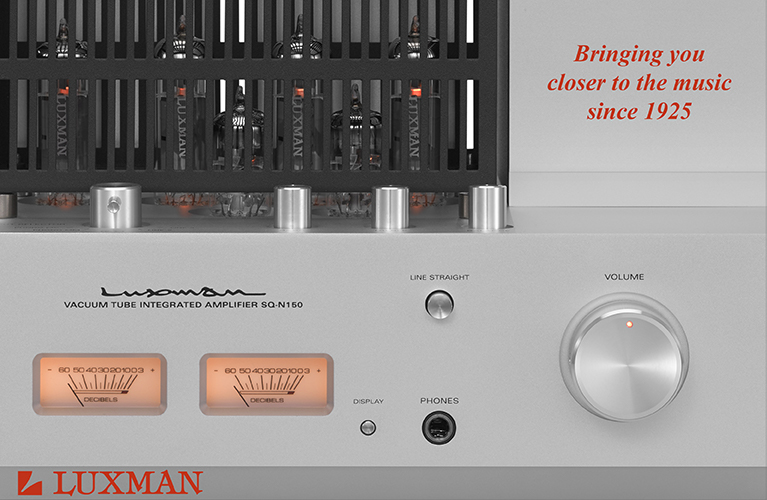Over the past few years, the vast majority of my music purchases -- and I’m not alone in this -- have been of downloadable files rather than discs. Nonetheless, I still have a substantial collection of discs that I continue to listen to. On the home-theater side, most audio/video receivers now include the ability to play music files -- including high-resolution FLACs and, in some cases, DSD files -- from USB keys and network storage devices. Two-channel integrated amplifiers and receivers still, generally, eschew such features. Thus, connected to my amplifier are a disc player and a computer.
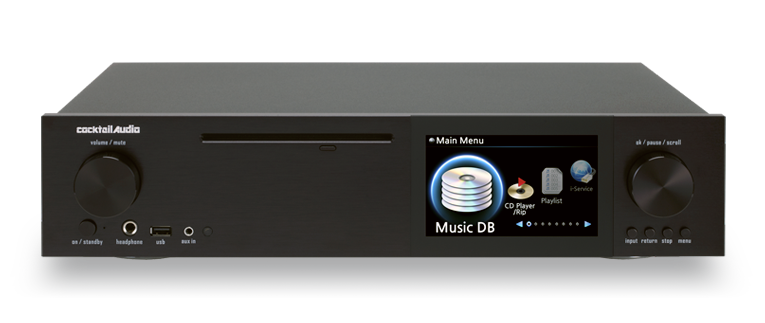
Designers of music servers are now combining these functions in a single source component that can handle both file- and disc-based digital music. In 2012, I reviewed a music server from Autonomic Controls and was less than impressed, especially at the price. In fact, I remained unconvinced of the usefulness of the product category. The competition, or more accurately the baseline of comparison, is not simply other audio components of the category, but a computer. To replace a computer, a music server must be able to play all relevant formats, quickly, and get out of the way, and do all of this more elegantly than a computer. And the sound quality needs to be more than an afterthought.
Over the past few years, Korea’s Novatron has released four music servers under the brand name Cocktail Audio: the X10, X12, X30, and X40. They share a core of features, particularly those related to ripping and organizing music, along with an interface for playback, a headphone output, lines in and out, Ethernet connectivity, and USB host ports. However, the feature sets vary with the price.
The X10, starting at $580 USD (with 2TB hard drive), is a compact component measuring 7”W x 3.9”H x 5.9”D with a 3.5” screen, a CD drive, a ripper, a music database, a hard-drive caddy, USB and network playback, and Internet Radio based on Reciva’s system. It also has an optical output capped at 24-bit/96kHz, a headphone amp, and a power-amp with speaker spring clamps that outputs 30Wpc into 8 ohms.
The X12 ($699), the same size as the X10, upgrades that model’s spring-clamps to binding posts, bumps the screen size to 4.3”, replaces a fan with passive cooling, and can pass 24/192 PCM from its optical or coaxial outputs, or decode it with its Cirrus Logic CS4351 DAC.
The X30 ($1695), a full-size audio component at 17”W x 3.9”H x 12.7”D, received much praise at its launch. It has a 5” screen, the ubiquitous Burr-Brown PCM1792A DAC, an FM tuner, optical and coaxial inputs, the addition of an AES/EBU digital output, HDMI output for its graphical user interface (GUI), and an increase in amplification to 50Wpc.
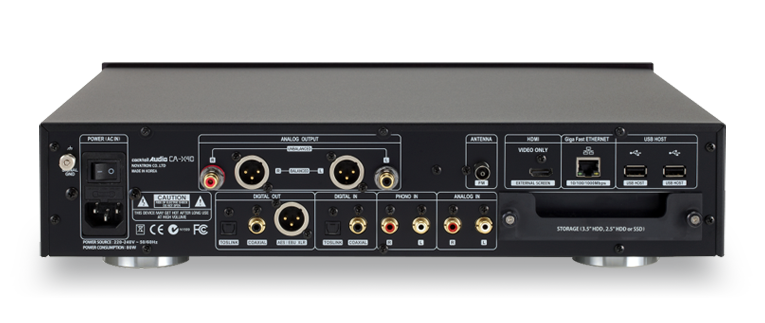
New in 2014, the X40 ($2695), which is the same size as the X30, is marketed as a true audiophile component that can play DSD64/128/256/DXD and PCM up to 32/384, and that boasts a Sabre ES9018K2M DAC, a moving-magnet phono stage, and balanced analog outputs on XLR connectors. In contrast to its less-expensive siblings, the X40 has no built-in amplification.
Features
My review sample of the X40 arrived in a cloth bag and double-boxed. Included were a remote control, a power cord, an FM antenna lead, and a data disc containing a copy of FreeDB, software for tagging the contents of CDs ripped when offline. (When connected to the Internet, the X40 will directly consult the online version of FreeDB.) What I first noticed as I set up the X40 was how nice it looked -- its 12mm-thick faceplate of brushed aluminum exuded quality. Also on the front are a slot-loading CD-ROM drive, a headphone jack, a USB Type A port, a 3.5mm Auxiliary input, an On/Standby button, and buttons for menu navigation: Input, Return, Stop, Menu. At either end of the front panel is a 1.5”-wide knob: Mute/Volume on the left, and OK/Pause/Scroll on the right; the knobs turn smoothly, with detents. To the right of the disc slot is the 5” LCD screen, with a resolution of 800x480 pixels.
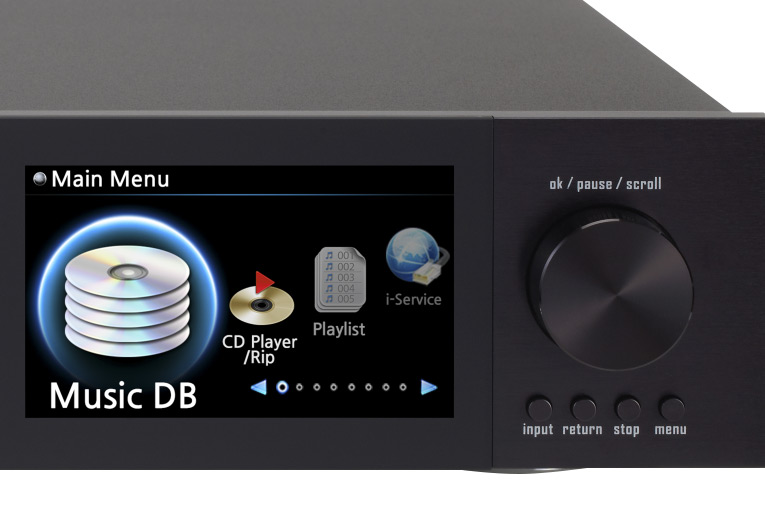
On the rear panel are the phono ground, the power-supply switch, and the grounded IEC connector. The power supply is rated for 80W, similar to what one finds in small-form-factor computers. The balanced (XLR) and unbalanced (RCA) analog audio outputs are widely spaced -- I had to peel back the molding of my unbalanced interconnects to separate the ends. The digital outs comprise TosLink, coaxial, and AES/EBU (XLR). There are TosLink and coaxial digital inputs, a moving-magnet phono input, and an analog line in. All RCA connectors and XLR pins are gold plated. The FM antenna connector is of the push-in rather than screw-in type, so I had to adapt the screw-terminal lead of my Fanfare antenna. An HDMI video output is provided, but this is for only a larger screen display; it does not pass along audio signals. The X40’s GUI can be displayed on its front panel or on an external TV, not on both simultaneously. Unfortunately, every time I tried to toggle to display on my television, the X40 froze -- or so I thought. It turned out that the X40 was just very slow: 46 seconds to switch to sending a 720p signal via HDMI, and 62 seconds to switch back. For most of my listening, I used the front-panel display.
The X40 connects to a network via a gigabit Ethernet port or optional Wi-Fi USB adapter; I plugged the Ethernet into a nearby 100-megabit switch, which proved fast enough for playback from my Synology networked-attached storage (NAS), but I swapped in a gigabit switch for transfers of larger clumps of data (e.g., entire albums). The X40 can serve as an UPnP media server and renderer. I was able to access and mount as read-only the X40’s Music Database share, which contains the music files, by simply accessing the Uniform Naming Convention (UNC) \\X40 in Windows. As it is read-only, a way to load music (such as eClassical downloads) is to mount the X40’s My Recordings folder (which is writable) and copy the music there. The X40’s Import function copies from storage to the Music Database. In my setup, I download to my PC’s hard drive and run Microsoft’s SyncToy to push new music files to a “music” share on my NAS. I also have this action set to run weekly in Windows Task Scheduler. (In Linux, one can similarly set up rsync and crontab.) I then pushed files to the X40 from my NAS and imported them to the Music Database for playback. It’s a roundabout procedure, but it worked.
The rear panel has two USB Type A host ports and a hard-drive caddy for connecting storage. The caddy supports 3.5", 2.5", and SSD drives with SATA data and power connectors, much as in a laptop computer. The X40’s bottom plate is vented; it has no fans. The only noise is the occasional sound of the hard drive seeking from the Seagate SATA 400GB DB35.3, which StorageReview.com has rated in the middle of the range for idle noise, at around 40dB. While I could hear the X40’s hard drive from across the room -- it added 2dB to my room’s level of noise, as measured at my listening chair with Smart Tools’ Sound Meter for Android -- the noise was not distracting when playing back music.
The X40’s innards consist of a MIPS 700MHz processor, LG Super Multi DVD Writer GA50 (slot loading), a variety of custom PC boards, and a toroidal power supply that would be more at home in an audio component than a computer. All in all, Cocktail Audio’s X40 is a well-put-together component that offers the user plenty of flexibility in use.
Setup
The X40 is a complex device, but I got started with it without too much trouble. I began by plugging in its power cord and Ethernet cable, and connecting its unbalanced analog output to my NAD C 356BEE integrated amp. Eventually, more for testing than for daily use, I added connections for digital in/out and my turntable. As delivered, the X40 could serve as one’s sole digital source, with the caveat that it can’t support high-resolution discs, such as DVD-Audio or the DSD layers of SACDs. Unlike with some solutions, you don’t have to connect the X40 to an external display or control it with a mobile device or PC. In fact, the X40 could be used in a computer-free household -- just add amp and speakers.
The boot-up process took about a minute, during which the X40 displays an image of a martini glass, as a reminder that it’s made by Cocktail Audio. Given that this boot time is much longer than that of any of my recent computers, I tested how much power the X40 would use if I left it on at all times, and whether leaving it in Standby or Sleep would shorten the startup time. According to a Kill-a-Watt, the X40 used no power in Standby or Sleep but between 14 and 20W when on, depending on whether the disc drive was active. Startup from Sleep still took a minute. Given its thirst for juice, I decided that I could wait a minute for the X40 to boot.
When the X40 is ready, its screen displays icons for Setup, Music DB, Playlist, i-Service, CD Play/Rip (grayed out if no disc is inserted), FM Radio, Browser, and Input. i-Service accesses the three Internet streaming services -- Reciva, Simfy, and Qobuz -- while Input switches among the digital inputs, phono in, and analog line in. As measured with Audacity’s Contrast routine, the built-in phono stage has a relatively high noise floor. I wanted to compare the X40’s built-in phono stage to my Cambridge Audio Azur 540P phono preamplifier, but when I connected the Azur to the X40’s analog line input, I heard nothing. Connecting a CD player, SACD player, or tuner also produced no sound -- clearly, the analog line input was not working. Browser accesses the Recordings folder on the X40’s internal hard drive (i.e., recordings made from FM radio and the various inputs, not ripped music), connected USB devices, network shares, and UPnP servers. My Synology DS211j NAS had both Samba and DLNA servers running, but the X40 was able to connect only to the DLNA; I was able to connect to the Samba server via Android, ChromeOS, Linux, and Windows devices.
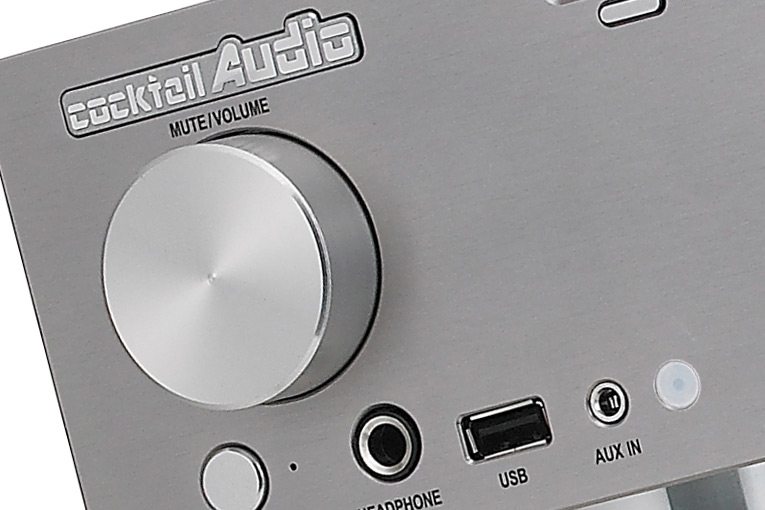
To load the Music DB, I inserted Anat Cohen’s Notes from the Village (CD, Anzic ANZ-1302) and was presented with a list of the disc’s tracks. At that point one can play the album or, by pressing Menu, rip it to Music DB. I’d previously, in the Setup menu, set the X40’s default ripping format to FLAC; other choices are WAV, MP3, OGG, and ALAC. The X40 took 9:29 to rip and compress the CD -- much slower than the 2:21 it took Exact Audio Copy to rip and compress to FLAC on my computer. Nonetheless, ripping on the X40 is very simple and straightforward. Music can also be imported from the internal hard drive (such as recordings from the FM tuner or turntable), USB (flash drive, or self- or bus-powered hard drive), or CD-ROM. Importing from a UPnP source is not supported. I was able to import a FLAC rip of Patricia Kaas’s Tour de Charme (16/44.1 FLAC, Sony) from a bus-powered USB hard drive in just under two minutes. Importing across the network would be a very useful feature to include in a software update. As it is, one would need to copy files to \\X40\LocalStorages\hdd1\My Recording, then import them to the X40’s local hard drive. Having the X40 suck files in from a NAS would be more convenient.
Backup, too, was slow. I did a full backup of the 187GB stored on the X40’s internal hard drive to a USB hard drive using the Cocktail’s backup utility, and it took 28 hours, 39 minutes (the front panel includes a timer) -- a rate of 1.81MB/s when USB 2.0 can, in theory, transfer at 60MB/s. I popped out the X40’s internal drive and connected it to my Windows computer using the same Vantec USB 2.0 drive adapter, and transferred data at 24MB/s; hooking up a SATA cable would be even faster. Fortunately, the X40 uses a standard file system that both Windows and Linux can read, and lists files by album and track title. I recommend performing backups using a computer. One could even map the X40’s Music DB share to a drive letter and schedule a backup task -- in Windows, I like SyncToy for this -- to copy over the network. Still, over a 100mbps network, it was relatively slow at 4.8MB/s.
The X40 offers several ways to browse music that have been loaded into the database. While falling short of the multiplicity of choices SoundStage!’s Vade Forrester enjoyed with the Digibit Aria, what the X40 provides will meet most users’ needs. The eight browse options for the music database, called Display Modes, are selectable in Setup: Track Title, Album, Artist/Track, Artist/Album, Genre/Track, Genre/Album, Composer/Track, Composer/Album. The Composer option -- not found in all such products -- is especially helpful for browsing recordings of classical music. Of course, the organization is only as good as the metadata, which relies on FreeDB and manual changes made by the user. These edits to the tags -- title, artist, album, composer, year, genre -- can easily be made on the X40 itself by connecting a USB keyboard.
One problem I’ve always had with music servers is their scalability: It’s easy to manage a few albums, but how well does a server deal with hundreds? By offering a variety of browsing mechanisms, the X40 scales fairly well, showing eight items per screen and scrolling fluidly -- but there’s no way around the fact that large collections will require a lot of scrolling. For such collections, controlling from an iOS, Android, or Web app is a good choice. Cocktail recommends PlugPlayer for iOS, and PlugPlayer or BubbleUPnP for Android. The X40’s built-in Web server provides a Web-based interface with the media library. Then the user can browse, search, and filter the list by Track Title, Artist, Album, and Genre -- and, surprisingly, by Track Number, Year, Time (duration), and Bitrate. Cocktail Audio, if you’re reading this: Composer, format, and sample-rate fields would also be useful. When a track has been found, a menu button brings up several options, including start play, add to queue, add to a playlist, edit tags, and trigger filters, to find tracks that match the selected track’s artist, album, genre, or composer. I often built a queue or playlist from my Chromebook, then switched to the X40’s infrared remote to control playback.
The X40 is a new product, but with the X30 Cocktail has established a good track record for issuing firmware updates, with three releases in the last year for fixes and enhancements. This is essential -- a product with so many features is bound to have problems that need to be addressed. If you’ve ever spent any time reviewing the changelog notes in firmware, OS, or software updates, among the most common are “stability improvements” -- boring but essential. While the X40 was rock solid during playback, there were several scenarios in which it would freeze, mainly while I was navigating the menu and/or switching out of playback.
For example, after playing a 16/44.1 FLAC album for half an hour from my NAS, connected by Ethernet over a 100Mbps network, I pressed Stop on the X40’s remote to switch to another album. The X40 promptly froze, and its screen blanked out to a dull gray -- but the playback did stop. Other buttons, of Cancel, Back, and Power, had no impact, whether pressed on the remote or on the front panel. After several minutes of waiting, the only escape was to turn off the X40 using its rear-panel power switch, which can’t be good for the internal hard drive. I experienced the same problem when stopping Internet Radio playback, though sometimes it was merely slow -- it took ten seconds to halt music playback from Naim Records’ Internet station. Controlling playback off of the local hard drive was always responsive.
Listening
Using the Cocktail X40’s digital output, I was able to compare its Sabre ES9018K2M DAC with the Cirrus Logic CS4398 DAC in my integrated amp. This was my first experience with the Sabre chip, but I’d been impressed with Sabre’s ES9023, used in the Resonessence Concero DAC. The X40’s digital output can be set to resample signals of any resolution up to 192kHz or pass it along. I selected pass-through, which includes DSD -- which, like many DACs, my amp’s DAC doesn’t support. Another useful option would be to distinguish PCM from DSD: “Pass-through PCM and convert DSD to 192kHz PCM.” My Sony BDP-S590 BD player uses a similar logic. When I listened to the Quartetto Italiano’s recording of Schubert’s last four string quartets (16/44.1 FLAC, Philips), the X40 offered greater clarity and a sense of a third dimension to the soundstage. Although there was less punch in the forte passages, there was greater control and separation. Switching to the digital output stripped the far left and right extensions from the soundstage. The tonalities of the violins, viola, and cello also became less distinct. Only when I switched back to the Cocktail’s Sabre was I able to be sure that the Quartetto Italiano was using mutes in these performances. Each step higher in Cocktail’s product line provides a better DAC, and part of what one pays for with the X40 is its quality of digital-to-analog conversion. And remember, it was listening through the X40’s unbalanced outputs that so pleased me. The X40 also provides balanced outputs, for those with amps that can accommodate it.
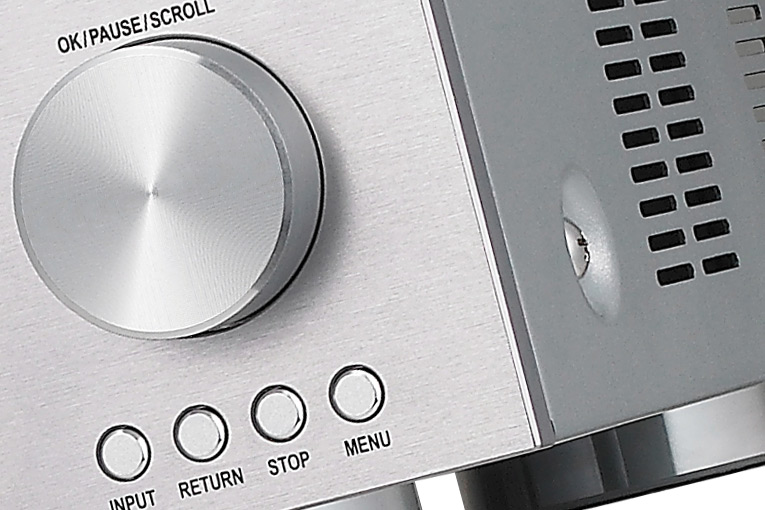
With hi-rez recordings, such as guitarist Bucky Pizzarelli’s Swing Live (24/96 FLAC, Chesky), the X40 presented a precise image of an ensemble arrayed across a live stage. Peter Appleyard’s vibraphone resonated musically in “Lester Leaps In,” with a natural rate of decay following each stroke. Throughout the album, the solos were handed off fluidly. The X40 exuded clarity, detail, and precision, all while maintaining a tone that was neither too bright nor too warm. This was particularly evident with clarinetist Allen Vanche’s stratosphere-scraping solos and the well-controlled patterns of Bernard Purdie’s tom-toms. Throughout, this recording was rendered in an engaging manner; the advantages of hi-rez recordings were unmistakable.
Listening to Tor Espen Aspaas’s recording of Beethoven’s Piano Sonata No.32, Op.111 (DFF/DSD64, 2L), and using the X40’s built-in DAC in both cases, level matched on my easy-to-drive Grado SR80 headphones, the X40’s headphone output, while quite powerful, was less crisp and well defined than the headphone amp built into my NAD integrated amp. Each keystroke had a bit of haze and sounded less lifelike, particularly in the midrange, which sounded plasticky; and in the low range, the X40 boomed. The NAD delivered somewhat more dynamic range -- the X40 was never able to get down to “dead quiet.” At the end of each track or album or playlist, an annoying click was audible through headphones directly connected to the X40, though I never heard this through speakers or an external headphone amp. While the X40’s headphone amp is serviceable, the X40 should be paired with an external headphone amp.
Conclusion
Despite the few problems described above, I was, on the whole, very impressed with the Cocktail Audio X40. This was the first music server I’d encountered that convinced me of the usefulness of this product category. In the X40, Cocktail has paired the ease of use of an audio component with the scalability of a computer. The X40’s GUI and display work well for pulling together collections of files from various sources -- rips and downloads, local or on the network -- and it can play directly from a CD, FM radio, or a connected turntable. I’ve never seriously considered ripping all my CDs -- it would be a big project -- but with the advantages in organization of the X40’s Music DB, I’d likely do so if I owned one. In the X40, one gets a ripper, a server, a renderer, a tuner of both Internet and FM radio, and an excellent DAC, all tied together with a well-thought-out user interface. What’s not to like about that?
. . . Sathyan Sundaram
sathyans@soundstagenetwork.com
Associated Equipment
- Speakers -- Wharfedale Diamond 8.2, PowerCube 10 subwoofer
- Headphones -- Grado SR80
- Analog sources -- Goldring GR1 turntable, Rega Research RB100 tonearm, Goldring Elektra cartridge; Cambridge Audio Azur 540P phono preamplifier; Sangean HDT-1 tuner
- Digital sources -- Music Hall MMF CD-25 CD player; Pioneer DV-563A DVD/SACD/CD player; Sony BDP-S590 BD player; Roku XDS; Intel H61 desktop (2.6GHz, 8GB RAM, Crucial SSD) running Windows 8.1 Professional (64-bit), foobar2000, with Realtek ALC887 DAC/optical output (WASAPI/ALSA drivers); Synology DS211j SMB/DLNA server
- Amplifier -- NAD C 356BEE with MDC DAC2
- Antenna -- Fanfare FM-2G
- Television -- Panasonic TC-P50S30
- Remotes -- Logitech Harmony Smart Control; Samsung Galaxy Player 5 (Android 2.3); Asus Nexus 7 (Android 5)
- Power conditioner -- APC Line-R LE1200
Cocktail Audio X40 Music Server
Price: $2695 USD.
Warranty: Two years parts and labor.
Cocktail Audio
Novatron Co., Ltd.
Room 1607, 13 Heungdeok 1-ro, Giheung-gu, Yongin-si
Geyonggi-do, 446-908
Korea
Phone: +82 31-898-8401
Fax: +82 31-898-8413
Website: www.cocktailaudio.com
US distributor:
Audio Plus Services
156 Lawrence Paquette Industrial Drive
Champlain, NY 12919
Phone: (800) 663-9352, (450) 585-0098
Fax: (866) 656-0686
Website: www.audioplusservices.com






















